South African Astronomical Observatory
South African Astronomical Observatory (SAAO) is the national centre for optical and infrared astronomy in South Africa. It was established in 1972. The observatory is run by the National Research Foundation of South Africa. The facility's function is to conduct research in astronomy and astrophysics. The primary telescopes are located in Sutherland, which is 370 kilometres (230 mi) from Observatory, Cape Town, where the headquarters is located.[1]
.jpg.webp) The Sutherland site of the South African Astronomical Observatory. With the Southern African Large Telescope. | |||||||||||||||||||
| Alternative names | SAAO | ||||||||||||||||||
|---|---|---|---|---|---|---|---|---|---|---|---|---|---|---|---|---|---|---|---|
| Organization | National Research Foundation of South Africa | ||||||||||||||||||
| Observatory code | 51, B31, A60 | ||||||||||||||||||
| Location | Headquarters in Observatory, Cape Town Major telescopes in Sutherland, Northern Cape | ||||||||||||||||||
| Coordinates | Headquarters: 33.9347°S 18.4776°E Sutherland: 32.3783°S 20.8105°E | ||||||||||||||||||
| Established | January 1972 | ||||||||||||||||||
| Website | www | ||||||||||||||||||
| Telescopes | |||||||||||||||||||
| |||||||||||||||||||
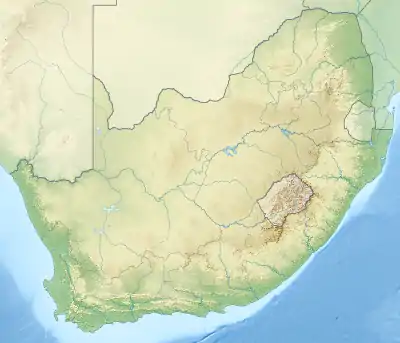 Location of South African Astronomical Observatory | |||||||||||||||||||
The SAAO has links worldwide for scientific and technological collaboration. Instrumental contributions from the South African Astronomical Observatory include the development of a spherical aberration corrector and the Southern African Large Telescope (SALT).
The Noon Gun on Cape Town's Signal Hill is fired remotely by a time signal from the Observatory.
History
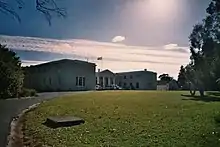
The history of the SAAO began when the Royal Observatory at the Cape of Good Hope was founded in 1820, the first scientific institution in Africa.[2] Construction of the main buildings was completed in 1829 at a cost of £30,000[3] (equivalent to £2.7 million in 2021[4]). The post of Her Majesty's astronomer at the Cape of Good Hope was awarded the Royal Medal on two occasions; the first to Thomas Maclear in 1869 for measurement of an arc of the meridian at the Cape of Good Hope[5] and the second to David Gill in 1903 for researches in solar and stellar parallax, and his energetic direction of the Royal Observatory at the Cape of Good Hope.[6]
The Republic Observatory, Johannesburg, was merged with the much older Royal Observatory, Cape of Good Hope in January 1972 to form the South African Astronomical Observatory. In 1974 the Radcliffe Observatory telescope was purchased by the CSIR and moved to Sutherland, where it recommenced work in 1976.
SAAO was established in January 1972, as a result of a joint agreement by the Council for Scientific and Industrial Research (CSIR) of South Africa and Science and Engineering Research Council (SERC) of United Kingdom. The headquarters are located on the grounds of the old Royal Observatory where the main building, offices, national library for astronomy and computer facilities are housed. Historic telescopes are also found at the headquarters in a number of domes and a small museum that displays scientific instruments. The South African Astronomical Observatory is administered at present as a National Facility under management of the National Research Foundation (NRF), formerly the Foundation for Research Development (FRD). In 1974, when the Radcliffe Observatory in Pretoria closed, the Council for Scientific and Industrial Research (CSIR) purchased the 1.9-m Radcliffe telescope and transported it to Sutherland.[7]
Facilities
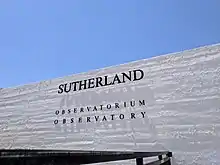
The observatory operates from the campus of the Royal Observatory, Cape of Good Hope that was established in 1820[8] in the suburb of Observatory, Cape Town.
The major observing facilities are however located near the town of Sutherland some 370 kilometres (230 mi)[1] from Cape Town.
Telescopes

0.50m telescope
This 0.5 metres (20 in) reflector was originally built for the Republic Observatory in 1967, but was moved to the Sutherland site in 1972.
0.75m telescope
A 0.75 metres (30 in) Grubb Parsons reflector.
1.0m Telescope
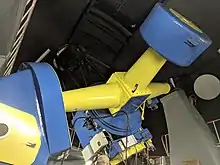
This 40 inches (1.0 m) telescope was originally located at SAAO Head office in Observatory, Cape Town, but has since moved to the Sutherland site.[9] This telescope participates in the PLANET network.[10]
1.9m Telescope
.jpg.webp)
The 1.9-m (74-inch) Radcliffe Telescope was commissioned for the Radcliffe Observatory in Pretoria where it was in use between 1948 and 1974. Following the closure of the Radcliffe Observatory it was moved to Sutherland where it became operational again in January 1976. Between 1951 and 2004 it was the largest telescope in South Africa.[11] The telescope was manufactured by Sir Howard Grubb, Parsons and Co.[12]
Alan Cousins Telescope (ACT)
This 29.5 inches (75 cm) telescope was originally called the Automatic Photometric Telescope, but has been renamed the Alan Cousins Telescope in honour of Alan William James Cousins.[13][14]
BiSON
One of six telescopes in the Birmingham Solar Oscillations Network
Infrared Survey Facility (IRSF)
The IRSF is a 140 centimetres (55 in) reflector fitted with a 3 colour Infrared Imager.[15] Originally built as part of the Magellanic Clouds – A Thorough Study grant from the Japanese Ministry of Education, Culture, Sports, Science and Technology in 2000.[16] Other studies the telescope participated in include:
- The Indian Department of Space used this telescope for the Near Infrared Survey of the Nuclear Regions of the Milky Way to improve on data from the DENIS and 2MASS Astronomical surveys.[17]
Las Cumbres Observatory Global Telescope Network
Three 1 metre (39 in) telescopes to form part of the LCOGT network were installed in early 2013.[18]
MASTER
The MASTER-SAAO Telescope (obs. code: K95) is part of the Russian Mobile Astronomical System of Telescope-Robots. It saw first light on 21 December 2014.[19] It consists of two paired 0.4-m telescopes.[20] In April 2015 it discovered the first comet from South Africa in 35 years, C/2015 G2 (MASTER).[21]
MONET
One of the two 1.20 metres (47 in) telescopes of the MOnitoring NEtwork of Telescopes Project is located at Sutherland. Its twin can be found at the McDonald Observatory in Texas.[22] The MONET telescopes are Robotic telescope controllable via the Internet and was constructed by the University of Göttingen.[23] Remote Telescope Markup Language is used to control the telescopes remotely.[24]
Project Solaris
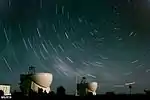
Two telescopes forming part of Project Solaris is located at the Sutherland site. Solaris-1 and Solaris-2 are both 0.5m f/15 Ritchey–Chrétien telescope. The aims of Project Solaris is to detect circumbinary planets around eclipsing binary stars and to characterise these binaries to improve stellar models.[25]
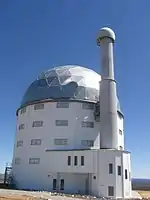
Southern African Large Telescope (SALT)
- Observatory Code: B31
- Observations: (Near Earth Objects)
SALT was inaugurated in November 2005. It is the largest single optical telescope in the Southern Hemisphere, with a hexagonal mirror array 11 meters across. SALT shares similarities with the Hobby-Eberly Telescope (HET) in Texas. The Southern African Large Telescope gathers twenty-five times as much light as any other existing African Telescope.[26] With this larger mirror array, SALT can record distant stars, galaxies and quasars.

SuperWASP-South
The Wide Angle Search for Planets consists of two robotic telescopes, the one located at SAAO Sutherland and the other at Roque de los Muchachos Observatory on the island of La Palma in the Canaries.[27] WASP-17b, the first exoplanet known to have a retrograde orbit was discovered in 2009 using this array.
KELT-South
KELT-South (Kilodegree Extremely Little Telescope – South) is a small robotic telescope that is designed to detect transiting extrasolar planets. The telescope is owned and operated by Vanderbilt University and was based on the design of KELT-North, which was conceived and designed at the Ohio State University, Department of Astronomy. The KELT-South telescope will serve as a counterpart to its northern twin, surveying the southern sky for transiting planets over the next few years.
Yonsei Survey Telescopes for Astronomical Research (YSTAR)
- Observatory Code: List of observatory codes § A60
The Yonsei Survey Telescopes for Astronomical Research (YSTAR), decommissioned in 2012, was used for the monitoring of variable stars and other transient events. YSTAR was a joint project between SAAO and the Yonsei University, Korea.[23]
Geophysical
South African Geodynamic Observatory Sutherland (SAGOS)
The GeoForschungsZentrum, Potsdam in co-operation with the National Research Foundation of South Africa constructed the SAGOS between 1998 and 2000.
SAGOS consist of a 1 Hz permanent GPS station, a superconducting gravimeter, meteorological sensors, and a tri-axial magnetometer. The GPS station is also used in support of the CHAllenging Minisatellite Payload (CHAMP) and Gravity Recovery and Climate Experiment (GRACE) space missions.[28]
SUR Station
The SUR station forms part of the International Deployment of Accelerometers Project and the Global Seismographic Network of the Incorporated Research Institutions for Seismology[29][30]
See also
- National Research Foundation of South Africa
- Astronomical Society of Southern Africa
- SEDS SEDS South Africa
- Other optical observatories and telescopes in South Africa
- Radio observatories and telescopes in South Africa
- Magnetic observatories in South Africa
References
- "Additional information about SAAO Sutherland". South African Astronomical Observatory. Archived from the original on 14 October 2010. Retrieved 3 October 2010.
- Laney, Dave. "The South African Astronomical Obsrvatory: Africa's Eye in the Sky". South African Department of Science and Technology. Archived from the original on 30 August 2009. Retrieved 30 January 2009.
- "THE TRANSIT OF VENUS.; THE EXPEDITION AT THE CAPE OF GOOD HOPE". The New York Times. 6 December 1874. Retrieved 16 July 2011.
- UK Retail Price Index inflation figures are based on data from Clark, Gregory (2017). "The Annual RPI and Average Earnings for Britain, 1209 to Present (New Series)". MeasuringWorth. Retrieved 2 February 2020.
- "Royal archive winners before 1900". The Royal Society. Retrieved 6 December 2008.
- "Royal Medal Winners:1949 – 1900". The Royal Society. Retrieved 1 December 2008.
- Heck, Andre (2002). Organizations and Strategies in Astronomy III. p. 160. ISBN 978-1-4020-0812-2.
- Holden, Edward Singleton (1888). "The Principal Observatories of the World". Hand-book of the Lick Observatory of the University of California. p. 112. Retrieved 2 October 2010.
- "The 40-inch Elizabeth telescope". South African Astronomical Observatory. Archived from the original on 19 September 2012. Retrieved 28 January 2009.
- "It's Far, It's Small, It's Cool: It's an Icy Exoplanet! Distant Planet Brings Astronomers Closer To Home" (PDF). Retrieved 15 May 2009.
- "Radcliffe 74-inch (1.9-m)". South African Astronomical Observatory. Retrieved 3 May 2017.
- Astronomical Instruments. Grubb Parsons. 1956.
- "The Alan Cousins Telescope – Automatic Photometric Telescope". South African Astronomical Observatory. Archived from the original on 9 September 2012. Retrieved 29 January 2009.
- "Automatic Photometric Telescope (APT)". Astronomical Society of Southern Africa. Archived from the original on 18 July 2011. Retrieved 29 January 2009.
- "IRSF telescope". South African Astronomical Observatory. Archived from the original on 9 September 2012. Retrieved 30 January 2009.
- Nagata, Tetsuya (2005). "IRSF 1.4-m telescope continues providing wonderful images at SAAO". The Astronomical Herald. 98 (3): 137–138. Bibcode:2005AstHe..98..137N. ISSN 0374-2466.
- Baliyan, K. S.; Ganesh, S.; Joshi, U. C.; Glass, I. S. (2003). "Near Infrared Survey of the Galactic Nuclear Bulge Region" (PDF). Bulletin of the Astronomical Society of India. 31: 403. Bibcode:2003BASI...31..403B.
- Brown, T. M.; Baliber, N.; Bianco, F. B.; Bowman, M.; Burleson, B.; Conway, P.; Crellin, M.; Depagne, É.; De Vera, J.; Dilday, B.; Dragomir, D.; Dubberley, M.; Eastman, J. D.; Elphick, M.; Falarski, M.; Foale, S.; Ford, M.; Fulton, B. J.; Garza, J.; Gomez, E. L.; Graham, M.; Greene, R.; Haldeman, B.; Hawkins, E.; Haworth, B.; Haynes, R.; Hidas, M.; Hjelstrom, A. E.; Howell, D. A.; Hygelund, J.; Lister, T. A.; Lobdill, R.; Martinez, J.; Mullins, D. S.; Norbury, M.; Parrent, J.; Paulson, R.; Petry, D. L.; Pickles, A.; Posner, V.; Rosing, W. E.; Ross, R.; Sand, D. J.; Saunders, E. S.; Shobbrook, J.; Shporer, A.; Street, R. A.; Thomas, D.; Tsapras, Y.; Tufts, J. R.; Valenti, S.; Vander Horst, K.; Walker, Z.; White, G.; Willis, M. (2013). "Las Cumbres Observatory Global Telescope Network". Publications of the Astronomical Society of the Pacific. 125 (931): 1031–1055. arXiv:1305.2437. Bibcode:2013PASP..125.1031B. doi:10.1086/673168. ISSN 0004-6280. S2CID 118585975.
- "First Light with MASTER-SAAO". SAAO – South African Astronomical Observatory. 23 December 2014. Retrieved 3 May 2017.
- MASTER-SAAO
- "C/2015 G2 (MASTER) is first South African Comet discovery in 35 years". Africa2Moon. Archived from the original on 12 May 2015. Retrieved 20 May 2015.
- "Research Facilities". McDonald Observatory. Retrieved 15 May 2009.
- "Telescopes". South African Astronomical Observatory. Retrieved 30 January 2009.
- Hessman, F. V.; Romero, E. (May 2003). "Running MONET and SALT with Remote Telescope Markup Language 3.0". American Astronomical Society Meeting 202, #38.09; Bulletin of the American Astronomical Society. 202: 753. Bibcode:2003AAS...202.3809H.
- P. Sybilski & S.K. Kozłowsk (August 2011). "Project Solaris – a Southern Hemisphere robotic telescope networ" (PDF). Monthly Notes of the Astronomical Society of Southern Africa. 70 (7&8): 131–135. Bibcode:2011MNSSA..70..131S. ISSN 0024-8266.
- "First Light". South African Large Telescope. Retrieved 15 May 2009.
- "Welcome to the WASP website". SuperWASP. Archived from the original on 8 December 2002. Retrieved 30 January 2009.
- "South African Geodynamic Observatory Sutherland (SAGOS)". Helmholtz Centre Potsdam GFZ German Research Centre for Geosciences. Retrieved 30 January 2009.
- "Geophysical Facilities". South African Astronomical Observatory. Retrieved 30 January 2009.
- "Station SUR, Sutherland, Republic of South Africa". Project IDA. Retrieved 30 January 2009.
Further reading
- Wiehahn, Michelle (February 2002). Using the SAAO Automatic Photometric Telescope to Study the Long-Term Lightcurves of Cataclysmic Variables (PDF) (BSc (Hons) thesis). University of Cape Town – Department of Astronomy. Archived from the original (PDF) on 21 August 2011.
External links
| Wikimedia Commons has media related to South African Astronomical Observatory. |
| External image | |
|---|---|
- Official Website
- SALT Homepage
- SALT milestones, first-light
- SALT milestones, inauguration
- BiSON Homepage
- SuperWASP Homepage
- KELT-South Homepage
- SuperWASP-South live status
- SUR listing at Project IDA
- South Africa's Giant New Observatory. Construction of the 1.9m Radcliffe Telescope, AP Archive.
- flicker